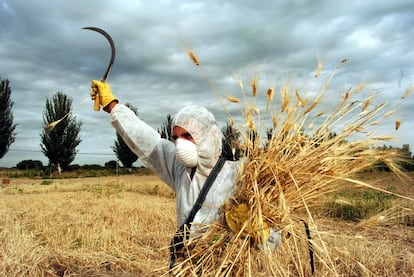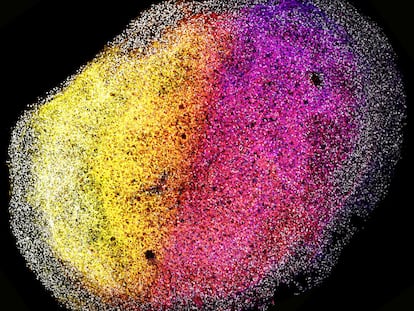In Kenya, Nigeria and Malawi, gene-editing is saving crops
A dozen genetic-editing projects for crops in Africa are achieving incredible results. For more than 20 years, European countries have been repressing this technology, due to pressure from certain environmental groups

On the African continent, a dozen genetic-editing projects are being put at the forefront of agriculture. However, for the past 20 years, European countries have been repressing this technology, due to pressure from certain environmental groups and — above all — uncritical acceptance by a large part of upper-income countries. These opinions contradict science. As Norman Borlaug — the father of the Green Revolution — noted in a past interview with EL PAÍS: “environmentalists oppose GMOs because their bellies are full.”
Greenpeace made the biggest mistake in its history by turning its opposition to GMOs into one of its main campaigns, alongside the rightful battles that it wages against radioactive waste, ocean pollution and climate change. Scientists have been pointing out this anomaly for decades, but the directors of Greenpeace have insisted on being on the side of irrationality… even after a hundred Nobel Prize winners accused them of crimes against humanity for maintaining this position. Fortunately, the situation is changing, right where it’s most-needed.
Sorghum is an essential crop in many African countries, not only for food, but also as building material. However, 60% of the continent’s fields are suffering from a devastating invasion of Striga hermonthica, a parasitic plant sometimes called “witchweed.” This weed attaches itself to the roots of sorghum and sucks away water and nutrients, until it destroys the entire crop.
Scientists from all over the African continent have solved the problem with CRISPR, the groundbreaking gene-editing technique that has revolutionized biology laboratories in recent years. Field trials will begin this year. Molecular biologist Steven Runo — from the University of Kenya in Nairobi — announced this at the Plant & Animal Genome Conference held in mid-January in San Diego, California.
CRISPR has two advantages over its transgenic predecessors. Firstly, it’s cheap and easy to use. This allows any country to modify seeds to solve its local problems — be they pests or nutritional deficiencies — instead of depending on those generated by a few multinationals, such as the defunct Monsanto, whose commercial practices were the main cause of opposition from environmentalists. But what we’re talking about now has nothing to do with Monsanto — rather, it has to do with human health and bolstering nutritional security in developing countries.
Secondly, CRISPR doesn’t require adding foreign genetic material to solve agricultural problems. In fact, it can introduce a genetic variant into a plant that already exists in nature and that, therefore, could be obtained through conventional crosses that farmers have used for 10 millennia. Nobody has the slightest ethical objection to such a process. Obtaining the desired hybrid sans technology, however, is a frustratingly slow process, especially given the pressing needs of low and middle-income countries. CRISPR achieves the same results in the blink of an eye. Dr. Runo has applied it successfully to the case of sorghum in Kenya.
While the members of the European Union debate about whether CRISPR deserves to be excluded from a ban on genetically-modified plants that it imposed 20 years ago (without the slightest scientific argument), various countries in Africa have pushed forward with more rational regulations.
Since 2022, Kenya, Nigeria and Malawi have approved that plants edited with CRISPR should be classified in the same way as any conventional variety. Uganda and Ethiopia are in the process of doing the same.
Sorghum is just the beginning. Regardless of what the EU stipulates, African and Asian countries will use genetic-editing more and more, because they have perceived that it will be useful to improve the nutrition of their human populations and their livestock. As far as we know so far, researchers working in Africa and Asia have set up projects to generate corn that’s resistant to necrosis, pearl millet that isn’t ruined by oxidation shortly after it’s grinded, peanuts that are resistant to infection by carcinogenic fungi and — going from the plant world to the animal world — cows that produce more milk, despite high temperatures.
Those who work at Greenpeace are good people with the best intentions. Many of their campaigns are laudable. If Greenpeace didn’t exist, it would have to be invented. But we all make mistakes on occasion. And it’s best to recognize this, to stop confusing the public and delaying vital advances for disadvantaged populations.
Sign up for our weekly newsletter to get more English-language news coverage from EL PAÍS USA Edition
Tu suscripción se está usando en otro dispositivo
¿Quieres añadir otro usuario a tu suscripción?
Si continúas leyendo en este dispositivo, no se podrá leer en el otro.
FlechaTu suscripción se está usando en otro dispositivo y solo puedes acceder a EL PAÍS desde un dispositivo a la vez.
Si quieres compartir tu cuenta, cambia tu suscripción a la modalidad Premium, así podrás añadir otro usuario. Cada uno accederá con su propia cuenta de email, lo que os permitirá personalizar vuestra experiencia en EL PAÍS.
¿Tienes una suscripción de empresa? Accede aquí para contratar más cuentas.
En el caso de no saber quién está usando tu cuenta, te recomendamos cambiar tu contraseña aquí.
Si decides continuar compartiendo tu cuenta, este mensaje se mostrará en tu dispositivo y en el de la otra persona que está usando tu cuenta de forma indefinida, afectando a tu experiencia de lectura. Puedes consultar aquí los términos y condiciones de la suscripción digital.
More information
Archived In
Últimas noticias
The complicated life of Francesca Albanese: A rising figure in Italy but barred from every bank by Trump’s sanctions
How Japan is trying to avert ‘digital defeat’
Pinochet’s victims grapple with José Antonio Kast’s rise in Chile
Reinhard Genzel, Nobel laureate in physics: ‘One-minute videos will never give you the truth’
Most viewed
- Pablo Escobar’s hippos: A serious environmental problem, 40 years on
- Why we lost the habit of sleeping in two segments and how that changed our sense of time
- Trump’s obsession with putting his name on everything is unprecedented in the United States
- Charles Dubouloz, mountaineering star, retires at 36 with a farewell tour inspired by Walter Bonatti
- The Florida Keys tourist paradise is besieged by immigration agents: ‘We’ve never seen anything like this’











































